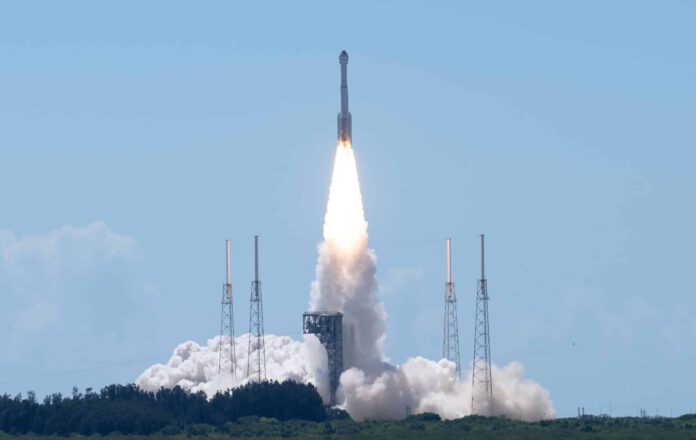
Historic Launch of Starliner
Astronauts Butch Wilmore and Suni Williams are currently safely in orbit, heading towards their highly anticipated destination: the International Space Station (ISS).
After years of delays, the moment had finally arrived: the launch of the first crewed Starliner test flight to the ISS. The astronauts launched successfully yesterday afternoon from Cape Canaveral, Florida. “Two brave NASA astronauts are well on their way during this historic first test flight with a brand-new spacecraft,” says NASA Chief Bill Nelson. “Boeing’s Starliner marks a new chapter in American space exploration.”
The Launch
Just before 5 PM (CET), the Starliner spacecraft was propelled into space by an Atlas V rocket. The launch went smoothly, and about half an hour later, the spacecraft performed an exciting maneuver to place it in the correct orbit around Earth. Soon after, the reassuring news came: Starliner had indeed reached a safe and stable orbit.
“With the launch of Starliner, the successful separation from the rocket, and achieving a stable orbit around the Earth, Boeing’s test flight is proceeding as planned,” says Mark Nappi, vice president and program manager of Boeing’s Commercial Crew Program. “All the focus is on ensuring a safe and comfortable journey for Suni and Butch, as well as successfully completing the test mission from start to finish.”
Tests in Space
During the flight to the ISS, Starliner will undergo various tests. NASA aims to determine if Starliner is ready for regular astronaut transportation to and from the ISS. This test flight will help validate several aspects, including the transport system, the launch platform, the rocket, the spacecraft, operational capabilities in orbit, and the safe return to Earth with astronauts onboard.
Initial maneuvers have already been executed. During one of these maneuvers, Wilmore and Williams briefly took control to demonstrate how Starliner can be manually operated. Although Starliner typically operates automatically, astronauts onboard may need to take over in certain situations. “The manual control is very precise,” Wilmore said. “It actually works better than the simulator. It’s amazing how accurately we can stop at a specific point.”
Manual Operations
During the demonstration, the crew pointed the front of Starliner towards Earth, so the communication dish at the back of the service module faced the TDRS satellites. They then turned Starliner so its solar panel was directed towards the sun to show that they can manually charge the internal batteries if needed. Following that, they turned Starliner to gaze at the stars, demonstrating that they can use the VESTA system manually to determine their position in space if all three onboard computers fail or shut down simultaneously. They also manually accelerated and then decelerated Starliner, altering their orbit slightly to showcase the ability to deviate from the space station’s orbit during a rendezvous if necessary. Later today, the astronauts will manually control Starliner to dock with the ISS.
Approaching the ISS
Wilmore and Williams are steadily approaching the ISS. Starliner is expected to approach the Harmony module of the space station around 6 PM (CET) and then safely dock. Wilmore and Williams will join Expedition Crew 71 and remain at the space station for approximately eight days. Besides transporting astronauts, the Boeing-built Starliner carries about 345 kilograms of cargo, including food and other supplies requested by the space station crew.
A Moment of Triumph for Boeing
The successful launch of the crewed Starliner is a significant and poignant moment for Boeing. The company has worked for years towards this milestone, but the journey was not always smooth. The first uncrewed test flight to the ISS in 2019 was a considerable setback. During that flight, aimed at demonstrating that the CST-100 Starliner was ready to carry astronauts, the spacecraft failed to reach the correct orbit shortly after launch, returning home without meeting the ISS. In 2021, another attempt was made, but propulsion issues forced Boeing to postpone the uncrewed test flight. After months of repairs, Starliner finally managed to reach the ISS successfully in May 2022. However, a crewed test flight was delayed for two more years. Although it was supposed to happen a month ago, technical issues once again grounded Starliner. Therefore, this successful launch feels like a massive victory. “Human spaceflight is a daunting endeavor, but it is worth it,” said Nelson. “This is an exciting period for NASA, our commercial partners, and the future of space exploration. Go Starliner, go Butch and Suni!”
In the coming hours, the two astronauts will conduct further tests. For now, everything seems to be functioning correctly. “This is a fantastic beginning,” said Ted Colbert, president and CEO of Boeing Defense, Space & Security. “We look forward to delivering the astronauts safely to the space station and then safely back home.”











